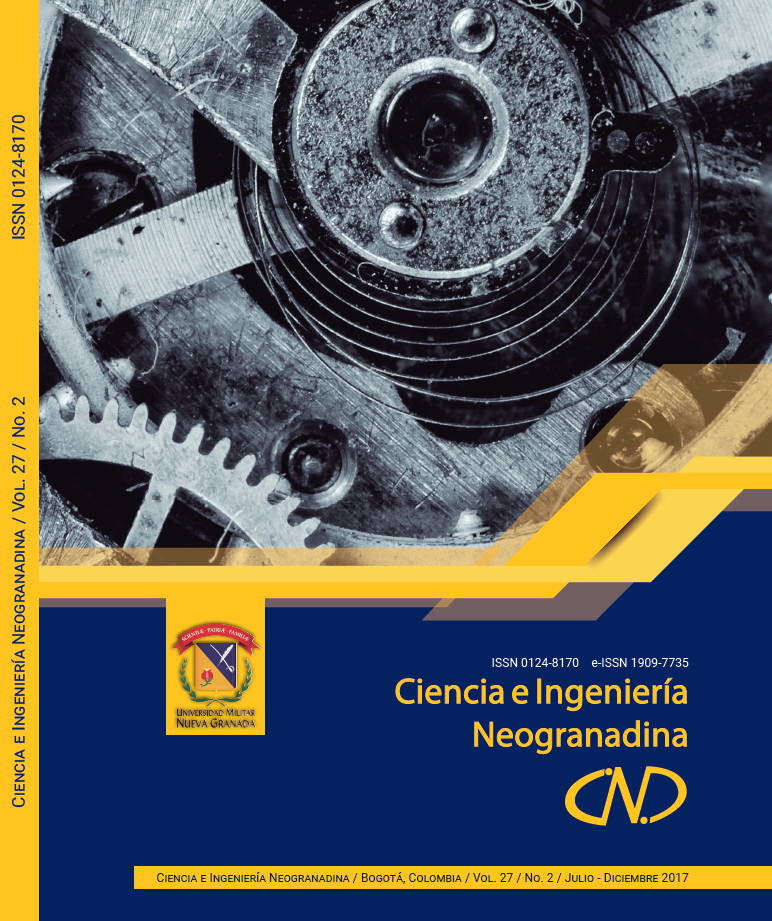Landfill leachate treatment by batch supercritical water oxidation
Abstract
Landfill leachate treatment has been the focus of a great deal of research through different physicochemical and biological methods. However, no single method successfully addresses the required destruction efficiencies regarding organic matter and nitrogen, which is why the treatment is done employing combined technologies. Supercritical water oxidation (SCWO), a process that takes place at temperatures and pressures above the critical point of water and in the presence of a source of oxygen, has been successfully applied to the treatment of different types of wastewaters in an efficient way. Therefore, this paper presents an experimental study of the supercritical water oxidation of landfill leachate in a batch reactor in the temperature range 400-500°C, reaction times from 15 to 30 minutes and oxygen excess (OE) from 100% to 300 %. Total organic carbon (TOC) and Total nitrogen (TN) destruction efficiencies were measured in the reactor effluent samples and the combined effect of the studied factors was analyzed by means of the Analysis of Variance (ANOVA). Optimal operation conditions for TOC destruction were 400°C, 30 min and 100 % OE, being 500°C, 30 min and 100 % OE for TN destruction. Contrary to what has been reported in similar studies, the results suggest that it is possible to accomplish the simultaneous TOC and TN destruction in leachate wastewater by SCWO treatment at 400°C, 100 % OE and residence times longer than 30 min and without using a catalyst, either in batch or in a continuous process, as long as both the oxidant and the wastewater are mixed and heated together at the reaction temperature.Downloads
References
P. Ghosh, I. S. Thakur and A. Kaushik, “Bioassays for toxicological risk assessment of landfill leachate: A review,” Ecotoxicol. Environ. Saf., vol.141, pp. 259-270, Jan. 2017. https://doi.org/10.1016/j.ecoenv.2017.03.023
T. A. Kurniawan, W. H. Lo and G. Y. S. Chan, “Physico-chemical treatments for removal of recalcitrant contaminants from landfill leachate,” Jour. Hazard. Mater., vol. 129, no. 1-3, pp. 80-100, 2006. https://doi.org/10.1016/j.jhazmat.2005.08.010
Y. N. Vodyanitskii, “Biochemical processes in soil and groundwater contaminated by leachates from municipal landfills (Mini Review),” Ann. Agrar. Sci., vol.14, no. 3, pp. 1512-1887, 2016. https://doi.org/10.1016/j.aasci.2016.07.009
N. B. Yenigül, A. M. M. Elfeki, J. C. Gehrels, C. van den Akker, A. T. Hensbergen and F. M. Dekking, “Reliability assessment of groundwater monitoring networks at landfill sites,” Jour. Hydrol., vol. 308, no. 1-4, pp. 1-17, 2005. https://doi.org/10.1016/j.jhydrol.2004.10.017
S. Renou, J. G. Givaudan, S. Poulain, F. Dirassouyan and P. Moulin, “Landfill leachate treatment: Review and opportunity,” Jour. Hazard. Mater., vol. 150, no. 3, pp. 468-493, 2008. https://doi.org/10.1016/j.jhazmat.2007.09.077
J. M. Ploeger, A. C. Madlinger and J. W. Tester, “Revised Global Kinetic Measurements of Ammonia Oxidation in Supercritical Water,” Ind. Eng. Chem. Res., vol. 45, no. 20, pp. 6842-6845, 2006. https://doi.org/10.1021/ie0605276
M. D. Bermejo, F. Cantero and M. J. Cocero, “Supercritical water oxidation of feeds with high ammonia concentrations Pilot plant experimental results and modeling,” Chem. Eng. Jour., vol.137, no. 3, pp. 542-549, 2008. https://doi.org/10.1016/j.cej.2007.05.010
L. Labiadh, A. Fernandes, L. Ciríaco, M. J. Pacheco et al., “Electrochemical treatment of concentrate from reverse osmosis of sanitary landfill leachate,” J. Environ. Manage., vol. 181, pp. 515-521, Oct. 2016. https://doi.org/10.1016/j.jenvman.2016.06.069
J. Xu, Y. Long, D. Shen, H. Feng and T. Chen, “Optimization of Fenton treatment process for degradation of refractory organics in pre-coagulated leachate membrane concentrates,” Jour. Hazard. Mater., vol. 323, pp. 674-680, 2017. https://doi.org/10.1016/j.jhazmat.2016.10.031
S. Renou, S. Poulain, J. G. Givaudan and P. Moulin, “Treatment process adapted to stabilized leachates: Lime precipitation-prefiltration-reverse osmosis,” Jour. Memb. Sci., vol. 313, no. 1-2, pp. 9-22, 2008. https://doi.org/10.1016/j.memsci.2007.11.023
J. R. Portela, E. Nebot and E. Mart, “Hydrothermal oxidation: Application to the treatment of different cutting fluid wastes,” Jour. Hazard. Mater., vol. 144, no. 3, pp. 639-644, 2007. https://doi.org/10.1016/j.jhazmat.2007.01.088
M. J. Cocero, E. Alonso and M. T. Sanz, “Supercritical water oxidation process under energetically self-sufficient operation,”. Jour. Supercrit. Fluids, vol. 24, no. 1, pp. 37-46, 2002. https://doi.org/10.1016/s0896-8446(02)00011-6
Y. García-Rodríguez, F. Mato, A. Martín, M. D. Bermejo and M. J. Cocero, “Energy recovery from effluents of supercritical water oxidation reactors,” Jour. Supercrit. Fluids, vol. 104, pp. 1-9, Sep. 2015. https://doi.org/10.1016/j.supflu.2015.05.014
V. F. Marulanda, “Biodiesel production by supercritical methanol transesterification: Process simulation and potential environmental impact assessment,” Jour. Clean. Prod., vol. 33, pp. 109-116, 2015. https://doi.org/10.1016/j.jclepro.2012.04.022
V. Marulanda and G. Bolaños, “Supercritical water oxidation of a heavily PCB-contaminated mineral transformer oil: Laboratory-scale data and economic assessment,” Jour. Supercrit. Fluids, vol. 54, pp. 258-265, Aug. 2010. https://doi.org/10.1016/j.supflu.2010.04.008
J. M. N. van Kasteren and a. P. Nisworo, “A process model to estimate the cost of industrial scale biodiesel production from waste cooking oil by supercritical transesterification,” Resour. Conserv. Recycl., vol. 50, no. 4, pp. 442-458, 2007. https://doi.org/10.1016/j.resconrec.2006.07.005
B. Cui, F. Cui, G. Jing, S. Xu et al., “Oxidation of oily sludge in supercritical water,” Jour. Hazard. Mater., vol. 165, no. 1-3, pp. 511-517, 2009. https://doi.org/10.1016/j.jhazmat.2008.10.008
M. Akg and O. Onur, “Treatment of textile wastewater by SCWO in a tube reactor,” Jour. Supercrit. Fluids, vol. 43, no.1, pp. 106-111, 2007.
X. Du, R. Zhang, Z. Gan and J. Bi, “Treatment of high strength coking wastewater by supercritical water oxidation,” Fuel, vol. 104, pp. 77-82, Feb. 2013. https://doi.org/10.1016/j.fuel.2010.09.018
B. Veriansyah, T. Park, J. Lim and Y. Lee, “Supercritical water oxidation of wastewater from LCD manufacturing process : kinetic and formation of chromium oxide nanoparticles,” Jour. Supercrit. Fluids, vol. 34, no. 1, pp. 51-61, 2005. https://doi.org/10.1016/j.supflu.2004.10.001
P. A. Marrone, “Supercritical water oxidation. Current status of full-scale commercial activity for waste destruction,” Jour. Supercrit. Fluids, vol. 79, pp. 283-288, Jul. 2013. https://doi.org/10.1016/j.supflu.2012.12.020
W. Gong and X. Duan, “Degradation of landfill leachate using transpiring-wall supercritical water oxidation (SCWO) reactor,” Waste Manag., vol. 30, no. 11, pp. 2103-2107, 2010. https://doi.org/10.1016/j.wasman.2010.04.028
S. Wang, Y. Guo, C. Chen, J. Zhang et al., “Supercritical water oxidation of landfill leachate,” Waste Manag., vol. 31, no. 9-10, pp. 2027-2035, 2011. https://doi.org/10.1016/j.wasman.2011.05.006
D. Zou, Y. Chi, C. Fu, J. Dong, “Co-destruction of organic pollutants in municipal solid waste leachate and dioxins in fly ash under supercritical water using H2O2 as oxidant,” Jour. Hazard. Mater., vol. 248-249, pp. 177-184, 2013. https://doi.org/10.1016/j.jhazmat.2013.01.005
K. Hatakeda, Y. Ikushima, O. Sato, T. Aizawa and N. Saito, “Supercritical water oxidation of polychlorinated biphenyls using hydrogen peroxide,” vol. 54, no. 15-16, pp. 3079-3084, 1999. https://doi.org/10.1016/s0009-2509(98)00392-3
E. Croiset, S. F. Rice and R. G. Hanush, “Hydrogen peroxide decomposition in supercritical water,” Am. Inst. Chem. Eng., vol. 43, no. 9, pp. 2343-2352, 1997. https://doi.org/10.1002/aic.690430919
M. Mukhopadhyay. Natural Extracts Using Supercritical Carbon Dioxide. Florida, USA: CRC Press, 2000. https://doi.org/10.1201/9781420041699
J. L. Dinaro, P. A. Marrone, S. F. Rice, P. A. Webley, “Critical review of kinetic data for the oxidation of methanol in supercritical water,” Jour. Supercrit. Fluids, vol. 34, no. 3, pp. 249-286, 2005. https://doi.org/10.1016/j.supflu.2003.12.018
D. C. Montgomery. Design and Analysis of Experiments (8th. Ed.). Nueva York: John Wiley & Sons, 2012.
B. Veriansyah, J. Kim and J. Lee, “Destruction of chemical agent simulants in a supercritical water oxidation bench-scale reactor,” Jour. Hazard. Mater., vol. 147, no. 1-2, pp. 13-19, 2007. https://doi.org/10.1016/j.jhazmat.2006.12.040
R. Killilea, K. C. Swallow and G. T. Hong, “The Fate of Nitrogen in Supercritical-Water Oxidation,” Jour. Supercrit. Fluids, vol. 5, no. 1, pp. 72-78, 1992. https://doi.org/10.1016/0896-8446(92)90044-k
G. Knothe, A. C. Matheaus and T. W. Ryan, “Cetane numbers of branched and straight-chain fatty esters determined in an ignition quality tester,” Fuel, vol. 82, no. 8, pp. 971-975, 2003. https://doi.org/10.1016/s0016-2361(02)00382-4
K. M. Benjamin and P. E. Savage, “Supercritical Water Oxidation of Methylamine,” Ind. Eng. Chem. Res., vol. 44, no. 14, pp. 5318-5324, 2005. https://doi.org/10.1021/ie0491793
S. Yesodharan, “Supercritical water oxidation : An environmentally safe method for the disposal of organic wastes,” Current Science, vol. 82, no. 9, pp. 1112-1122, 2002.
Z. Fang, S. K. Xu, R. L. Smith Jr., K. Arai and J. A. Kozinski, “Destruction of deca-chlorobiphenyl in supercritical water under oxidizing conditions with and without Na2CO3,” Jour. Supercrit. Fluids, vol. 33, no. 3, pp. 247-258, 2005. https://doi.org/10.1016/j.supflu.2004.08.010
T. E. Butt, E. Lockley and K. O. K. Oduyemi, “Risk assessment of landfill disposal sites - State of the art,” Waste Manag., vol. 28, no. 6, pp. 952-964, 2008. https://doi.org/10.1016/j.wasman.2007.05.012
J. A. Reyes-López, J. Ramírez-Hernández, O. Lázaro-Mancilla, C. Carreón-Diazconti and M. M. L. Garrido, “Assessment of groundwater contamination by landfill leachate: A case in México,” Waste Manag., vol. 28, no. 1, pp. 33-39, 2008. https://doi.org/10.1016/j.wasman.2008.03.024











